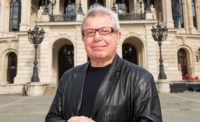 |
| Photo courtesy Studio Daniel Libeskind |
Although his design for a "Freedom Tower" was replaced by SOM¹s One WTC, Daniel Libeskind helped shape the rebuilding at the World Trade Center through his competition-winning master plan. RECORD editors Cathleen McGuigan, Clifford Pearson, and William Hanley interviewed Libeskind in his New York office overlooking the WTC site. Here are some excerpts from the conversation.
On the special character of Ground Zero: This is now a site that has memory in it. This is a site where people perished. This is a site which forever has altered how we view New York and the world. And so you cannot just rebuild in a careless way. You have to pay homage to that act, to that memory. You know you can’t just rebuild two towers again because things have changed. But at the same time you have to reaffirm that New York is a 21st-century city in terms of public space, accessibility, a good environment, and creating neighborhoods, not just stand-alone buildings.
On the planning process: It’s like a ticking clock and every second there’s someone calling, someone coming up to say I want this, I want that. As the master planner, my responsibility is to move the project ahead in a positive way, to understand it as a dynamic process.
It’s getting all these diverse and powerful interests aligned to create a place in the city that is meaningful.

On criticism that his plan has been subverted: I disagree. Many people think the plan has changed. It hasn’t. The fundamental idea was: Don’t build where people perished. Create a site of memory. But at the same time create something positive. Don’t shift New York into a register of sadness. Create vital streets. Create a central community. I think we have done this. The end result is very, very close to what I was trying to do — which was to devote almost half of the 16-acre site to public space — almost 8 acres — not just open space, but street connections and links to neighborhoods like Chinatown, Battery Park City, the World Financial Center, and Tribeca. We were successful in moving the large tower, One WTC, away from Wall Street where the developers originally wanted it and locating it near the Hudson where there’s air to breathe.
On security: We live in a democracy; democracies are vulnerable.
We have to address threats, but we don’t have to be stupid about security issues. We have to create a city that is not a fortress — a city that is accessible, fun to be in, pleasant.
On whether he likes One WTC: I do. It’s not my tower. I wouldn’t have designed it the same way. But it’s a very successful tower.
On whether he will be there on September 11: Yes, of course



Post a comment to this article
Report Abusive Comment